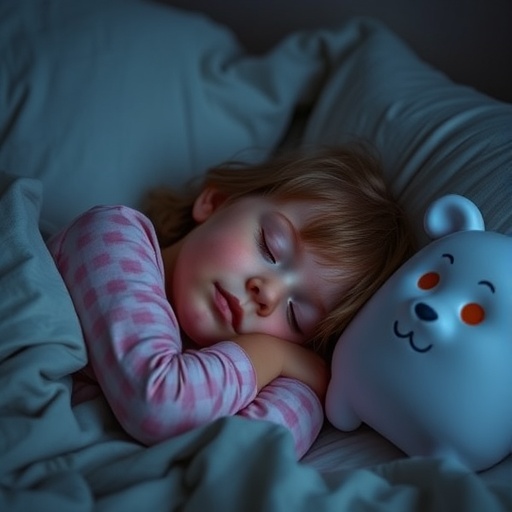In a groundbreaking study conducted by Brown University researchers, new light has been shed on the complex realities of elementary school children’s sleep patterns, revealing a substantial disconnect between parental perceptions and actual sleep behaviors. Published in Frontiers in Pediatrics, this research meticulously tracked 102 children over a week to analyze the intricacies of sleep duration, latency, and fragmentation, highlighting critical concerns about the sleep health of young Americans.
Despite the common parental assumption that once a child is tucked into bed they swiftly transition into restful slumber, objective sleep monitoring tells a different story. By employing wrist-worn accelerometers, the study precisely recorded when children went to bed, how long it took them to fall asleep, instances of nocturnal awakenings, and the total amount of sleep obtained each night. Concurrently, parents completed surveys and daily sleep diaries, providing subjective accounts of their children’s rest, allowing researchers to compare perceived sleep with physiological reality.
Remarkably, while 83% of parents believed their children were getting adequate sleep, only 14% of the young participants met the national sleep guidelines as defined by the American Academy of Pediatrics, which recommend 9 to 12 hours of sleep per night for children aged 6 to 12. The objective data revealed an average sleep duration of just eight hours and twenty minutes, significantly less than parental reports, which suggested children were sleeping over nine and a half hours. This discrepancy underscores a pervasive overestimation of children’s sleep by caregivers.
Delving further, the study uncovered that one major source of this disparity lies in unnoticed periods of wakefulness after bedtime. Children spent an average of 38 minutes awake during the night, a figure starkly contrasted by parents’ estimation of fewer than 5 minutes. This finding draws attention to the subtle but substantial fragmentation of sleep that parents may overlook, often assuming their children remain asleep after lights out.
The researchers also explored the often-overlooked dimension of racial and ethnic disparities in sleep among children. With Latino children comprising 56% of the study cohort, the data revealed that Latino participants averaged slightly over eight hours of sleep, whereas non-Latino children averaged eight and a half hours. More strikingly, only 4.4% of Latino children met national sleep recommendations compared to 22.8% of their non-Latino counterparts, pointing towards significant inequities in sleep quantity that could have long-term health implications.
Assessing parental awareness of sleep difficulties, the study found that Latino caregivers were more likely to report concerns about their children’s sleep and acknowledged more frequent difficulties in maintaining continuous sleep. Conversely, non-Latino parents tended to underestimate or underreport sleep-related problems, suggesting cultural variations in the recognition and communication of sleep issues.
Culturally influenced practices, such as later bedtimes, co-sleeping, and room sharing common in Latino households, emerged as potential factors affecting both sleep behaviors and parental perceptions. These environmental and behavioral variables might not only contribute to reduced sleep duration but also complicate parents’ ability to accurately gauge their children’s sleep quality, signaling a need for culturally informed approaches in sleep health interventions.
The technical methodology of the study leveraged the use of wrist-worn activity monitors, which utilize accelerometry to estimate sleep by detecting movement patterns. While these devices are widely validated and non-invasive, the authors caution that they may overestimate sleep time by misclassifying periods of quiet wakefulness as sleep. This limitation is important to consider, as it implies that even the objectively measured sleep times might be inflated, thus reinforcing concerns about insufficient sleep among children.
In response to these findings, the researchers advocate for enhanced communication strategies between healthcare providers and families to address the multifaceted nature of sleep health. Emphasizing the importance of establishing consistent, healthy sleep routines, the team encourages parents to implement evidence-based practices that promote optimal rest, including fixed bedtimes, restricted screen use before sleep, and ensuring appropriate exposure to natural light and physical activity during the day.
This study pushes the frontier of pediatric sleep research by integrating objective and subjective sleep measures and highlighting population-specific disparities. Its implications reach beyond academia, stressing the necessity for public health initiatives that target not only sleep duration but also sleep quality and parental understanding, with tailored interventions acknowledging cultural diversity.
The urgent need to address insufficient sleep among children resonates deeply given the well-documented consequences of chronic sleep deprivation, which include impaired cognitive function, behavioral issues, and increased risk for metabolic and cardiovascular disorders. This study’s nuanced insights pave the way for more effective approaches to safeguard children’s health by recognizing and rectifying the sleep gaps invisible to many parents.
As sleep researchers continue to unravel the intricate interplay between environment, behavior, and physiology, this investigation from Brown University underscores that putting a child to bed does not guarantee the restorative sleep crucial for healthy development. It calls for a concerted effort—from families, clinicians, educators, and policymakers—to prioritize and protect children’s sleep, thereby fostering their overall well-being and academic success.
Subject of Research: Sleep patterns and parental perceptions in elementary school children, with emphasis on racial and ethnic disparities.
Article Title: Associations between objectively and subjectively measured sleep outcomes among elementary school children in Rhode Island
News Publication Date: 21-Sep-2025
Web References: https://www.frontiersin.org/journals/pediatrics/articles/10.3389/fped.2025.1622943/full
References: DOI: 10.3389/fped.2025.1622943
Keywords: Health and medicine, Diseases and disorders
Tags: American Academy of Pediatrics guidelinesBrown University sleep studychildren’s sleep habitschildren’s sleep patternsdiscrepancies in sleep reportsnocturnal awakenings in childrenparental perceptions of sleeppediatric sleep researchsleep duration and latencysleep fragmentation in childrensleep health in childrensleep monitoring technology





